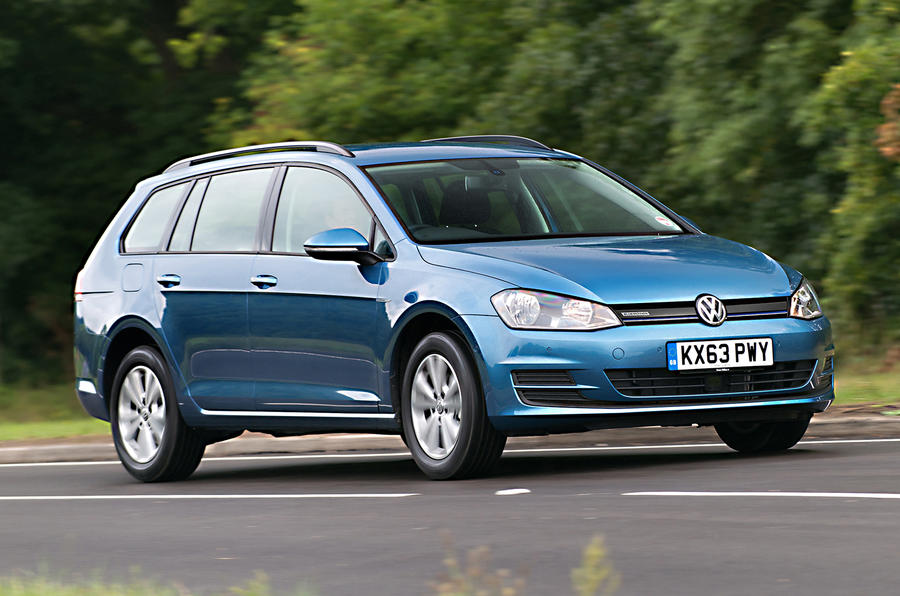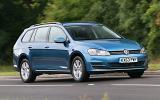What is it?
Probably one of the country’s most recognisable cars. However, here in estate form the Volkswagen Golf almost blends into the background, its distinctive hatchback shape gone in deference to this more practical wagon.
Not only is this estate practical, but it’s also incredibly economical, given that it’s the full-on BlueMotion version. Volkswagen calls all of its eco models ‘BlueMotion’, putting them through a rigorous process of engineering nips, tucks and tricks to maximise fuel efficiency and lower CO2 emissions.
Such measures include cutting the weight of the running gear by 26kg, a masked front grille and longer gear ratios. This standalone BlueMotion model is in addition to the BlueMotion Technology modifications that are standard on all Golfs. The estate model sports pretty similar figures to the standard hatchback, though. Claimed economy is slightly down on the estate compared to the hatch (85.6mpg versus 88.3mpg), which is no doubt down to weight and the fact that the estate shape is not as aerodynamically slippery as the hatchback.
What's it like?
Compared to the previous Golf estate the new car is longer, wider and lower – and this BlueMotion model is lowered by another 15mm to help it slip through the air that bit more efficiently. There’s also a lot more boot space than with the old car – a voluminous 605 litres, no less, which trounces the Ford Focus estate (which can only manage 476 litres). It can’t quite beat a Civic Tourer (Honda’s engineers figuried out how to fit 624 litres into their estate's rear regions). The most eco-friendly diesel Honda can’t quite match the VW’s CO2 and economy figures, though.
In BlueMotion form the estate doesn’t come with a spare wheel (to save on weight), so the underfloor cargo area seems huge when there’s no spare sat there. That rear space is also very practical, with cubbies to each side and levers handily placed by the boot hatch to drop the split-fold rear seats. Plus the tonneau cover has two settings, so that you don’t have to reach all the way to the rear bench to pull it back into place.
All the other Golf attributes are clear and present. Despite all the weight savings, the estate’s ride is just as comfortable as that of a normal Golf. VW’s engineers have given the BlueMotion more power than the normal S, so the car is certainly no slouch; there’s plenty of low-down torque for swift overtaking when you need it. In terms of refinement, however, VW’s 1.6-litre diesel engines are being left behind compared to those offered by Honda and Renault-Nissan. Also we were particularly impressed recently by Vauxhall’s new aluminium-blocked 1.6 unit in its Astra Sports Tourer.
Should I buy one?
The BlueMotion isn’t cheap at £22,165. If you consider the normal 1.6-litre S TDI is only £18,325 you have to figure out whether the extra miles that the BlueMotion can go on a tank of fuel are worth the difference.
The buying decision is probably more down to CO2 figures than economy, since this model emits only 87g/km, whereas the standard TDI registers 102g/km. When company car drivers do the maths it might work out more economical to have the BluMotion in terms of tax and miles driven. Or you might just prefer the fact that this car is kinder to the world and so be happy to pay the extra.


















Join the debate
Add your comment
Baffling
Boot space
Also, only measuring to the window line means they've been able to round off the roof-line of estate cars sharply without affecting the headline boot figures (thus hiding the loss of space), which may be good for emissions and economy, but is silly when the whole point of having an estate is extra space. Current Insignia Tourer vs old Vectra Estate is a good example, with seats folded: Vectra C:1850 liters - Insignia:1503! And yet the old "boot space to window line" metric makes the Insignia look bigger with 540L vs 530L...
Still, given how popular "Sports Tourers" are with their heavily curved back-ends, I must be in a small minority of wanting an estate that actually has a boot... Nobody seemed to like the Vectra estate, but the Insignia Tourer does seem to make a large proportion of sales. So what do I know? :)
£22k?